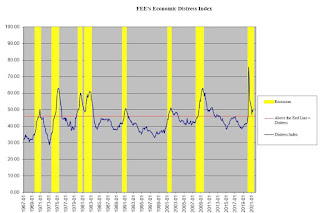Economic Distress Index
The data begins in January 1967.
Updated June 2021
Updated June 2021
Methodology:
The goal being simplicity, the Distress Index uses no more than a handful of statistics. The included statistics were chosen because they are widely held to be significant and uncontroversial. All the data for the index is collected by the Federal Government.
Included Statistics:
- Unemployment: A measurement of unemployed individuals collected by the Bureau of Labor Statistics.
- Consumer Price Index: The official measure of inflation kept by the Bureau of Labor Statistics.
- Gross Domestic Product: GDP is the market value of all final goods and services in a particular geographic area over a period of time. It is the most widely recognized measure of the “health” of economy. The DI substracts percent change in the GDP from the previous year from the index. Source: St. Louis Federal Reserve.
- Total Capacity Utilization (TCU): This is a measure of the utilization of the all available capital goods. The DI uses one minus this percentage, since higher utilization is generally a good thing. So for instance, if TCU is at 70 percent, we would add 30 percent to our index as a measure of the idle capacity. Source: St. Louis Federal Reserve
- Household Financial Obligations as a percent of Disposable Personal Income (FODSP): This measure is intended to gauge the ability of individuals to participate in the consumer economy. Source: St. Louis Federal Reserve
It is important to emphasize that no statistic will ever fully articulate what is happening in the real economy. The real economy is made up of living, breathing, planning, acting individuals. Statistics are simply an abstraction and, as such, imperfect. Nevertheless, FEE feels this index has substantial value for two reasons.
First, it gives us a tool to help interpret what the media and government are telling us about the economy. Second, we hope it will give voice to the taxpayer and the frustrating conditions he or she is enduring these days. We hope the index will keep pressure on policy makers and opinion leaders to make decisions that improve the economy rather than distressing it further.








